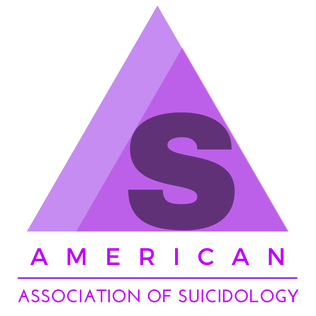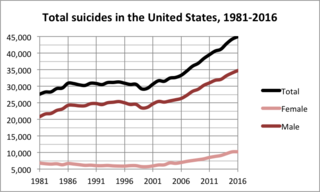Related Research Articles
Gay bashing and gay bullying is an attack, abuse, or assault committed against a person who is perceived by the aggressor to be gay, lesbian, bisexual, or transgender. The attack may be physical or verbal. This can also include abuse, bullying or assaults perpetrated against a heterosexual person whom the attacker perceives to be LGBT.

GLSEN is an American education organization working to end discrimination, harassment, and bullying based on sexual orientation, gender identity and gender expression and to prompt LGBT cultural inclusion and awareness in K-12 schools. Founded in 1990 in Boston, Massachusetts, the organization is now headquartered in New York City and has an office of public policy based in Washington, D.C.
The suicide rate in the United States remains comparatively high for the 15 to 24 age group with 6,241 suicides in this age range in 2017, making it the second leading cause of death for that age range.

An estimated 1 million people worldwide die by suicide every year. Globally, suicide ranks among the three leading causes of death among those aged 15–44 years. Attempted suicides are up to 20 times more frequent than completed ones.
Suicide intervention is a direct effort to prevent a person or persons from attempting to take their own life or lives intentionally.
The Trevor Project is an American nonprofit organization founded in 1998 focused on suicide prevention efforts among lesbian, gay, bisexual, transgender, queer, and questioning (LGBTQ) youth. Through a toll-free telephone number, it operates The Trevor Lifeline, a confidential service that offers trained counselors. The stated goals of the project are to provide crisis intervention and suicide prevention services for the aforementioned youths, as well as to offer guidance and resources to parents and educators in order to foster safe, accepting, and inclusive environments for all youth, at home and at school.
Gender is correlated with the prevalence of certain mental disorders, including depression, anxiety and somatic complaints. For example, women are more likely to be diagnosed with major depression, while men are more likely to be diagnosed with substance abuse and antisocial personality disorder. There are no marked gender differences in the diagnosis rates of disorders like schizophrenia, borderline personality disorder, and bipolar disorder. Men are at risk to suffer from post-traumatic stress disorder (PTSD) due to past violent experiences such as accidents, wars and witnessing death, and women are diagnosed with PTSD at higher rates due to experiences with sexual assault, rape and child sexual abuse. Nonbinary or genderqueer identification describes people who do not identify as either male or female. People who identify as nonbinary or gender queer show increased risk for depression, anxiety and post-traumatic stress disorder. People who identify as transgender demonstrate increased risk for depression, anxiety, and post-traumatic stress disorder.

The questioning of one's sexual orientation, sexual identity, gender, or all three is a process of exploration by people who may be unsure, still exploring, or concerned about applying a social label to themselves for various reasons. The letter "Q" is sometimes added to the end of the acronym LGBT ; the "Q" can refer to either queer or questioning.
Closeted and in the closet are metaphors for lesbian, gay, bisexual, transgender, LGBTQ+ people who have not disclosed their sexual orientation or gender identity and aspects thereof, including sexual identity and sexual behavior. It can also be used to describe anyone who is hiding part of their identity because of social pressure.

The Think Before You Speak campaign is a television, radio, and magazine advertising campaign launched in 2008 and developed to raise awareness of the common use of derogatory vocabulary among youth towards lesbian, gay, bisexual, transgender, queer/questioning (LGBTQ) people. It also aims to "raise awareness about the prevalence and consequences of anti-LGBTQ bias and behaviour in America's schools." As LGBTQ people have become more accepted in the mainstream culture more studies have confirmed that they are one of the most targeted groups for harassment and bullying. An "analysis of 14 years of hate crime data" by the FBI found that gays and lesbians, or those perceived to be gay, "are far more likely to be victims of a violent hate crime than any other minority group in the United States". "As Americans become more accepting of LGBT people, the most extreme elements of the anti-gay movement are digging in their heels and continuing to defame gays and lesbians with falsehoods that grow more incendiary by the day," said Mark Potok, editor of the Intelligence Report. "The leaders of this movement may deny it, but it seems clear that their demonization of gays and lesbians plays a role in fomenting the violence, hatred and bullying we're seeing." Because of their sexual orientation or gender identity/expression, nearly half of LGBTQ students have been physically assaulted at school. The campaign takes positive steps to counteract hateful and anti-gay speech that LGBTQ students experience in their daily lives in hopes to de-escalate the cycle of hate speech/harassment/bullying/physical threats and violence.

The American Association of Suicidology (AAS) is a 501(c)(3) nonprofit organization which advocates for suicide prevention. It was established in 1968 by Edwin S. Shneidman, who has been called "a pioneer in suicide prevention." Its official journal is Suicide and Life-Threatening Behavior, published six times a year by Wiley-Blackwell.
Research has found that attempted suicide rates and suicidal ideation among lesbian, gay, bisexual, transgender (LGBT) youth is significantly higher than among the general population.
World Suicide Prevention Day (WSPD) is an awareness day observed on 10 September every year, in order to provide worldwide commitment and action to prevent suicides, with various activities around the world since 2003. The International Association for Suicide Prevention (IASP) collaborates with the World Health Organization (WHO) and the World Federation for Mental Health (WFMH) to host World Suicide Prevention Day. In 2011 an estimated 40 countries held awareness events to mark the occasion. According to WHO's Mental Health Atlas released in 2014, no low-income country reported having a national suicide prevention strategy, while less than 100% of lower-middle income countries, and almost a third of upper-middle and high-income countries had.
The You-Are-Loved Chalk Message Project was an annual US-wide initiative that combated hateful rhetoric aimed at the lesbian, gay, bisexual, transgender, and queer (LGBTQ) community through the use of positive, uplifting chalk messages. The project's mission was to send messages of hope to members of the LGBTQ community who were struggling with depression or feelings of isolation. It served as a suicide prevention awareness campaign for LGBTQ college students.

Suicide is a major national public health issue in the United States. The country has one of the highest suicide rates among wealthy nations. In 2018, there were 48,344 recorded suicides, up from 42,773 in 2014, according to the CDC's National Center for Health Statistics (NCHS). On average, adjusted for age, the annual U.S. suicide rate increased 24% between 1999 and 2014, from 10.5 to 13.0 suicides per 100,000 people, the highest rate recorded in 28 years. Due to the stigma surrounding suicide, it is suspected that suicide generally is underreported. In April 2016, the CDC released data showing that the suicide rate in the United States had hit a 30-year high, and later in June 2018, released further data showing that the rate has continued to increase and has increased in every U.S. state except Nevada since 1999. Surging death rates from suicide, drug overdoses and alcoholism, what researchers refer to as "deaths of despair", are largely responsible for a consecutive three year decline of life expectancy in the U.S. This constitutes the first three-year drop in life expectancy in the U.S. since the years 1915–1918.
Bullying is an undesirable, attacker behavior that often happens among school aged children and adolescents. This behavior happens more than one time. Both children who bully or are bullied may have serious mental problems. There are different types of bullying such as verbal, social, physical and cyber.
The National Action Alliance for Suicide Prevention is an American suicide prevention organization coordinating national efforts to advance the National Strategy for Suicide Prevention (NSSP). It is a public/private partnership that, according to them, "catalyzes planning, implementation, and accountability for updating and advancing the NSSP. The Action Alliance works on the 2001 National Strategy for Suicide Prevention and is an outgrowth of the Suicide Prevention Resource Center. The Action Alliance initially focused on three high-risk populations: LGBT youth, American Indians/Alaska Natives, and military/veterans. Part of the group's campaign will be to educate on the warning signs of suicide, promoting the National Suicide Prevention Lifeline, as well as community crisis clinics across the U.S.
Diego De Leo is an Italian professor, doctor and psychiatrist. Until August 2015, he was the director of the Australian Institute for Suicide Research and Prevention (AISRAP), World Health Organization Collaborating Centre on Research and Training in Suicide Prevention at Griffith University in Brisbane, Australia. He has been on the editorial board of Crisis: The Journal of Crisis Intervention and Suicide Prevention since 1990, was its Editor-in-Chief from 2008 to early 2018, and is now Editor emeritus of the journal. He is frequently quoted in Australian news reports as an expert on suicide prevention.
In society at large LGBT individuals especially youth are at a higher risk of depression, anxiety, and suicide. Though causes of mental health risk are complex, one oft cited reason for these higher risks is minority stress stemming from societal anti-LGBT biases and stigma, rejection, and internalized homophobia. A 2016 empirical study found a correlation between the percentage of Latter-day Saints in a U.S. State and the suicide rates of that State, surmising the reason was due to the Church of Jesus Christ of Latter-day Saints' stance on same-sex sexual relations. However, the study could not examine what percentages of the deaths were LGBT persons or the percentage that were Latter-day Saints. A 2002 research report found a negative correlation in suicide between LDS Church youth members and nonmember youth in Utah, finding higher levels of religiosity appear to be inversely associated with suicide, though the study does not take into account sexual orientation or gender identity and expression. Other studies have shown that LGBTQ Mormons and former Mormons experience higher rates of certain mental health disorders that are positively correlated with suicidality than the general population. One Snowball sampling study of 1,612 LGBT Mormon and former Mormon respondents in 2015 found that involvement with The Church of Jesus Christ of Latter-day Saints and being single and celibate or engaging in a mixed-orientation marriage are both associated with higher rates of depression and a lower quality of life for LGBT individuals. A nonprobability sampling technique observed clinically significant symptoms of complex post-traumatic stress disorder related to religious beliefs and experiences at high rates among affiliated and disaffiliated LGBTQ Mormons in the study.
LGBT youth vulnerability is the increased social vulnerability that lesbian, gay, bisexual, and transgender (LGBT) youth face compared to their heterosexual and cisgender peers. Due to this increased vulnerability, there are notable differences in the mental and physical health risks tied to the social interactions of LGBT youth compared to the social interactions of heterosexual youth. Youth of the LGBT community experience greater encounters with not only health risks, but also violence, due to their sexual orientation, self-identification, and lack of support from institutions in society.
References
- ↑ Burkhart, Kate (September 11, 2009). "Are you searching for "National Suicide Prevention Week"? Highlight these search terms in the article My turn: Together communities can prevent suicide". Juneau Empire. Archived from the original on 21 February 2014. Retrieved 14 June 2012.
- ↑ "Suicide Prevention Week to be marked by Thurs. vigil". Marion Daily Republican. September 8, 2009. Retrieved 14 June 2012.
- 1 2 3 4 Woods, Tyler (September 7, 2009). "This Week Is National Suicide Prevention Week". Emax Health. Retrieved 14 June 2012.
- ↑ "The Main Stream [sic?]: Suicide Prevention Week events around town". KVOA - Tucson, AZ. September 5, 2011. Retrieved 14 June 2012.[ dead link ]
- ↑ Murphy, Jay David (September 9, 2009). "Sen. Reid releases statement on his father's suicide 37 years ago". Digital Journal. Retrieved 14 June 2012.
- 1 2 "National Suicide Prevention Week Information & Media Kit" (PDF). Campaign media kit. American Association of Suicidology. Archived from the original (PDF) on 2012-06-02. Retrieved 14 June 2012.
- 1 2 "Suicide Soars". The Press-Courier. February 6, 1985. Retrieved 14 June 2012.
- ↑ "38th Annual National Suicide Prevention Week: Collaborations in Suicidology: Bridging the Disciplines September 9th - 15th, 2012". American Association of Suicidology. Archived from the original on 6 June 2012. Retrieved 14 June 2012.
- ↑ "National Suicide Prevention Week". Military.com. September 8, 2008. Retrieved 14 June 2012.
- ↑ Zeitlin, Arnold (February 7, 1985). "Psychologist Warns of International Suicide Epidemic Among Young". Schenectady Gazette. p. 4. Retrieved 14 June 2012.
- 1 2 Melin, Amy (September 11, 2008). "AFSP walkathon raises suicide awareness". Western Herald. Retrieved 14 June 2012.
- ↑ Jelinek, Pauline (September 5, 2008). "Army: soldier suicide rate may set record again". USA Today/Associated Press. Retrieved 14 June 2012.
- ↑ National Action Alliance for Suicide Prevention Tackles LGBT Suicide, (April 26, 2012), Kellan Baker and Josh Garcia, National Action Alliance for Suicide Prevention.
- ↑ Michaels, Sean (September 23, 2011). "Lady Gaga to meet with Obama over bullying: Singer plans to discuss anti-bullying legislation with president following fan's suicide". The Guardian. Retrieved 14 June 2012.
- ↑ Barnard, Linda (November 19, 2010). "Happy as Harry; A Grown-up Daniel Radcliffe Talks Bras, Girlfriends, Fame and New Opportunities as He Reflects on a Decade Playing the Boy Wizard". Toronto Star . p. E.1.
- ↑ "Neil Patrick Harris' Message to Gay Youth," October 3, 2010 on YouTube
- ↑ Estrada, Nora Alicia (December 7, 2010). "Dicen no al suicidio". Mural (in Spanish). Guadalajara, Mexico. p. 2.
- ↑ Moore, John (October 19, 2010). "Celebrities Flooding Internet with Anti-Gay Bullying Posts". Charleston Daily Mail . p. B.10.
- ↑ "Kim Kardashian Donates $50,000 to The Trevor Project". January 24, 2012. Retrieved January 24, 2012.
- ↑ "Darren Criss performs "Not Alone" at Trevor Live," December 13, 2010 on YouTube
- ↑ The Trevor Project: Dianna Agron Birthday Project Archived 2012-07-21 at the Wayback Machine
- ↑ "George Takei Calls Out Anti-Gay Arkansas School Board Member," November 1, 2010 on YouTube
- ↑ "Anderson Cooper, Dr. Oz to compete on 'Jeopardy' Power Players Week".
- ↑ Marc Malkin; Brett Malec (September 1, 2011). "Glee Star Kevin McHale Talks to Troubled Gay Youths". E! Online. Retrieved 14 June 2012.
- 1 2 "History of The Trevor Project". The Trevor Project. Retrieved 14 June 2012.
- ↑ Staff (October 13, 1998). "Trevor Lends a 24-Hour Ear to Youth". The Advocate (via Google Books). p. 14. Retrieved August 1, 2011.
...the nation's first toll-free 24-hour suicide prevention hot line for gay and questioning youth.
- ↑ "Suicide Prevention Week Information & Media Kit" (PDF). Media kit. American Association of Suicidology. Archived from the original (PDF) on August 25, 2005. Retrieved 14 June 2012.
- ↑ "National Suicide Prevention Week Information Kit" (PDF). Media kit. American Association of Suicidology. Archived from the original (PDF) on 4 March 2016. Retrieved 14 June 2012.
- ↑ "Massachusetts Psychiatric Society Recognizes National Suicide Prevention Week 2007". Massachusetts Psychiatric Society. Archived from the original on 13 July 2012. Retrieved 14 June 2012.
- ↑ "National Suicide Prevention Week Information & Media Kit" (PDF). Campaign media kit. American Association of Suicidology. Retrieved 14 June 2012.[ permanent dead link ]
- ↑ "National Suicide Prevention Week". Helping Others Prevent & Educate about Suicide. Retrieved 14 June 2012.
- ↑ "National Suicide Prevention Week in Florida: Several communities and organizations around the state and country are holding events this week to raise awareness and increase education on the issue". WCTV. September 7, 2010. Archived from the original on 4 March 2016. Retrieved 14 June 2012.
- ↑ "2012 National Suicide Prevention Week Information & Media Kit" (PDF). American Association of Suicidology. Archived from the original (PDF) on 16 July 2012. Retrieved 7 July 2012.